Fishing reel bearings have come a long way from simple guide sleeves to more advanced ball and roller bearing designs. These anti-friction bearings operate on the principle of rolling friction, using balls or cylinders to reduce friction and enhance reel performance. Upgrading the bearings in your fly reel can significantly improve casting performance and overall functionality, allowing for longer and smoother casts.
By reducing friction and vibration, upgraded bearings achieve higher spool speeds, resulting in enhanced casting distance. They can also contribute to a smoother line retrieval, ensuring a seamless angling experience. Additionally, upgrading to high-quality bearings can increase the durability and lifespan of your reel, saving you from frequent replacements or repairs.
Key Takeaways:
- Upgrading fly reel bearings can improve casting performance and overall functionality.
- Upgraded bearings reduce friction and vibration, resulting in longer and smoother casts.
- They can also enhance line retrieval and increase the durability of your reel.
- Choosing the right bearings for your specific fly reel model is crucial for compatibility and optimal results.
- Maintenance and lubrication are essential to ensure the optimal lifespan and functionality of upgraded bearings.
Understanding the Role of Bearings in Fly Reels
Bearings play a crucial role in the smooth operation of fly reels. Upgrading the bearings can have a significant impact on casting performance and overall reel functionality. These small but mighty components are responsible for reducing friction and vibration, allowing the reel to achieve higher spool speeds and ultimately resulting in longer and smoother casts.
When it comes to upgrading fly reel bearings, one popular option is ceramic bearings. Ceramic bearings are known for their exceptional performance, as they are lighter and stronger than traditional steel bearings. The use of ceramic bearings can further enhance the reel’s overall performance, providing anglers with even greater casting distance and accuracy.
It is important to note that not all bearings are created equal, and choosing the right bearings for your specific fly reel model is crucial. Each reel has its own specifications and requirements, so selecting bearings that are compatible and suitable for your reel is essential. This ensures optimal results and a seamless upgrade to your fly fishing gear.
The Benefits of Upgrading Fly Reel Bearings
Upgrading the bearings in your fly reel brings a multitude of benefits for anglers. Beyond improving casting performance, upgraded bearings can also enhance the reel’s overall functionality. By reducing friction and vibration, upgraded bearings enable smoother line retrievals, resulting in more efficient and enjoyable fishing experiences.
In addition to performance improvements, upgrading fly reel bearings can also increase the durability and lifespan of your reel. High-quality bearings are built to withstand the demands of frequent fishing outings, reducing the need for frequent replacements or repairs. This not only saves anglers time and money but also ensures that their gear remains reliable and performs optimally over time.
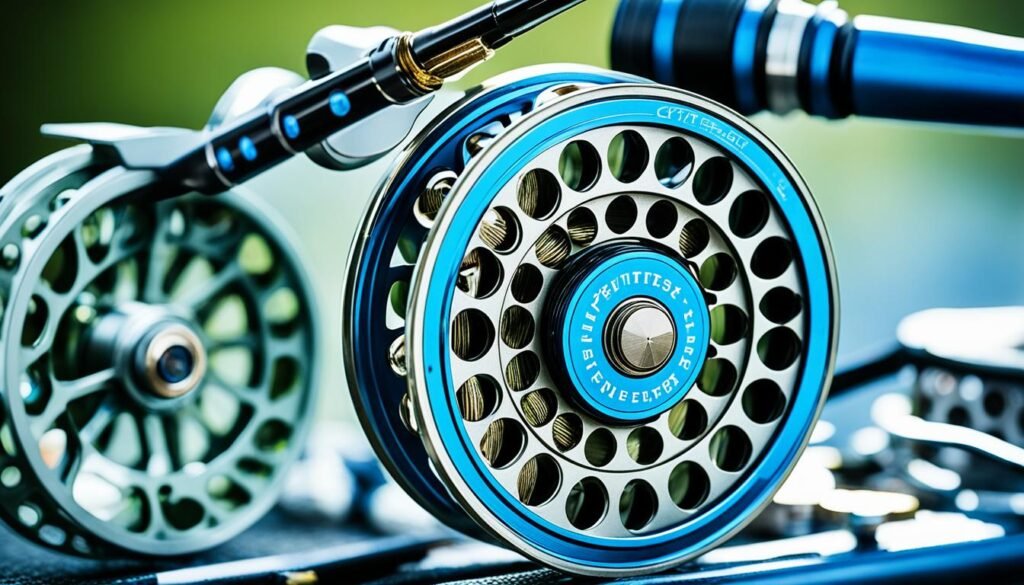
When considering an upgrade to your fly reel bearings, it is essential to choose reputable brands that offer reliable and high-quality options. By investing in the right bearings and ensuring proper installation, you can elevate your fly fishing experience to new heights.
Benefits of Upgrading Fly Reel Bearings
Upgrading fly reel bearings offers several benefits for anglers. Firstly, it can significantly improve the smoothness of the cast, allowing for more accurate and controlled casts. Upgraded bearings also contribute to enhanced reel performance by reducing friction and vibration, resulting in longer and smoother line retrieval. Moreover, upgrading to high-quality bearings can increase the overall durability and lifespan of the reel, saving anglers from frequent replacements or repairs.
| Benefits of Upgrading Fly Reel Bearings | |
|---|---|
| Improved cast smoothness | Upgraded bearings offer a smoother casting experience, allowing for more precise and controlled casts. |
| Enhanced reel performance | By reducing friction and vibration, upgraded bearings improve the overall performance of the reel, resulting in longer and smoother line retrieval. |
| Increased durability | High-quality bearings can significantly increase the durability and lifespan of the reel, reducing the need for frequent replacements or repairs. |
Upgrading your fly reel bearings is a smart investment that can greatly enhance your fly fishing experience. Whether you’re looking for smoother casts, improved reel performance, or increased durability, upgrading to the best bearings for fly reel upgrades is a worthwhile choice.
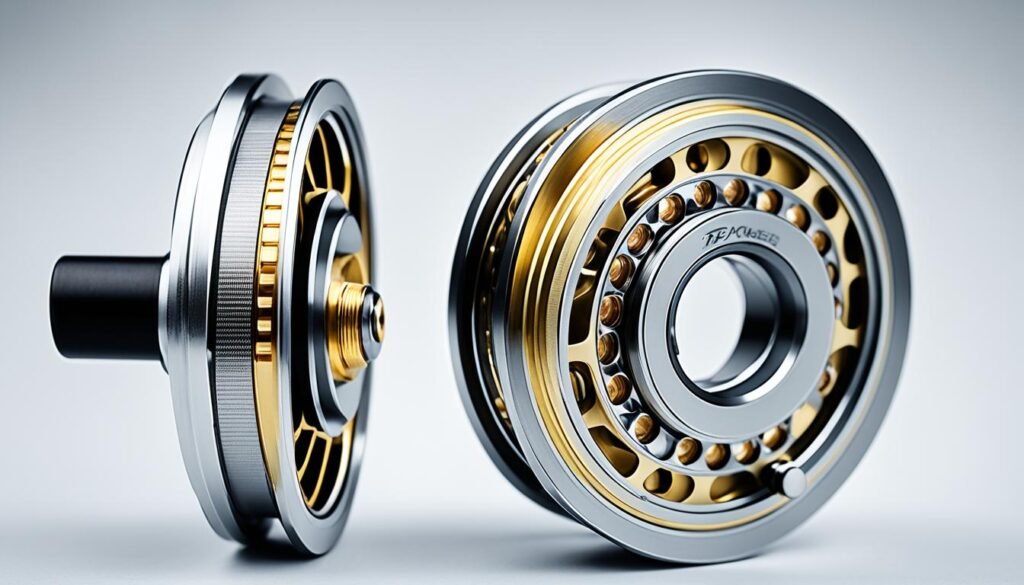
DIY Guide for Upgrading Fly Reel Bearings
Upgrading fly reel bearings can be a rewarding DIY project that improves the performance of your fly reel. With the right tools and knowledge, you can achieve a smoother cast and enhanced reel functionality. Here are some tips to guide you through the process:
1. Identify the Bearings Needed
Start by identifying the type and size of bearings required for your specific fly reel model. Consult the reel’s user manual or manufacturer’s website for this information. This step is crucial to ensure that you purchase the correct bearings for a successful upgrade.
2. Prepare the Reel
Before installing the upgraded bearings, it is essential to thoroughly clean the reel components. Remove the old bearings and clean any dirt or debris accumulated in the reel. A clean and well-prepared reel will promote optimal performance once the upgraded bearings are installed.
3. Install the Upgraded Bearings
Follow the manufacturer’s instructions for installing the upgraded bearings. Ensure that the bearings align properly and fit securely in the reel. Improper alignment or loose bearings can result in reduced performance or reel malfunction.
4. Reassemble and Test
After installing the upgraded bearings, reassemble the reel according to the manufacturer’s guidelines. Once reassembled, test the reel’s functionality to ensure smooth operation. Check for any unusual sounds or movements that may indicate a problem.
Pro Tip: Consult reel manuals or seek professional assistance if you encounter any difficulties during the upgrade process. It is better to get expert help than risk damaging your reel.
5. Regular Maintenance
After upgrading the fly reel bearings, it is crucial to prioritize regular maintenance. Clean the reel components periodically and apply a suitable lubricant to the bearings according to the manufacturer’s recommendations. Regular maintenance will help ensure the longevity and optimal performance of the upgraded bearings.
Upgrading your fly reel bearings as a DIY project can be a rewarding experience, allowing you to tailor your reel to your specific needs and preferences. However, if you are unsure or encounter any difficulties, don’t hesitate to seek professional assistance. With the right approach, your upgraded bearings can enhance your fly fishing experience and take your casting performance to the next level.
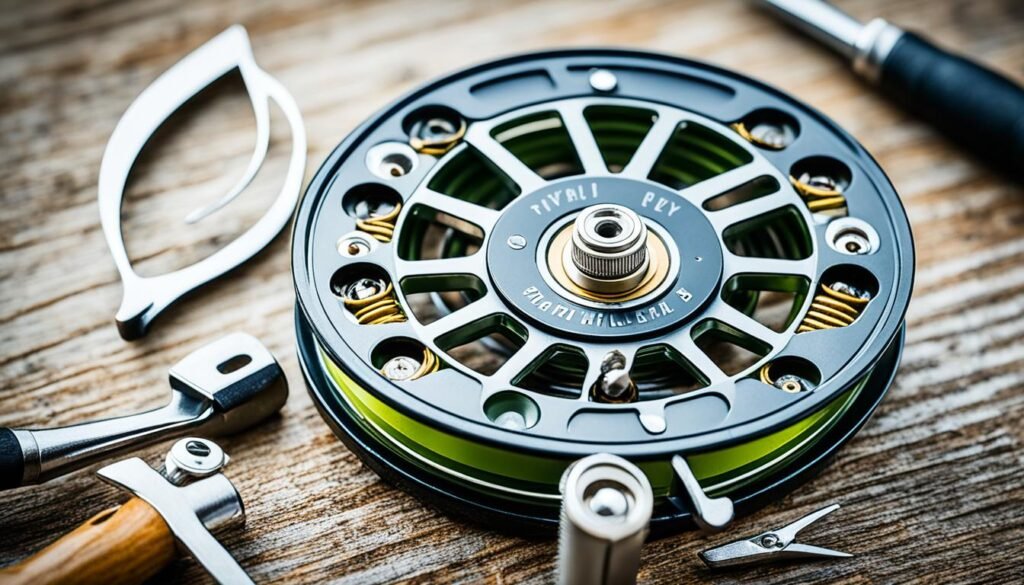
| Advantages | Considerations |
|---|---|
| Cost-effective compared to buying a new reel | Requires technical knowledge and skill |
| Customize reel performance to suit your preferences | Improper installation can lead to reel malfunctions |
| Increases the lifespan of your reel | May void the manufacturer’s warranty |
Recommended Upgrades and Maintenance Tips
In addition to upgrading the bearings, there are other maintenance tips and upgrades that can further enhance the performance of fly reels. Regular cleaning and lubrication of the reel components, including the drag system, gears, and handle, can prolong the lifespan and ensure smooth operation.
One crucial aspect of fly reel maintenance is the regular cleaning and lubrication of the reel components. This helps prevent dirt, debris, and saltwater corrosion from affecting the performance of the reel. When cleaning, use a mild soap or reel cleaner and a soft brush to remove any dirt or grime. Pay attention to the manufacturer’s recommendations regarding specific cleaning agents, as some chemicals may damage certain reel components.
After cleaning, thorough lubrication is essential. Apply an appropriate reel lubricant to the bearings, gears, and other moving parts. This lubrication not only reduces friction but also protects against corrosion and wear. Be sure to use a lubricant specifically designed for fishing reels, as general-purpose lubricants may have adverse effects.
An essential component to consider upgrading is the drag system, which controls the tension and smoothness of line retrieval. Depending on your fishing preferences, upgrading to a more advanced drag system can lead to smoother and more controlled fights with fish. The table below provides a comparison of some popular fly reel maintenance and upgrade accessories:
| Accessory | Description |
|---|---|
| Fly Reel Handle | Upgrading to a larger, more ergonomic handle can provide better grip and comfort during long fishing sessions. |
| Spool | Consider upgrading to a larger or lighter spool, depending on your fishing needs. A larger spool can store more backing and line, while a lighter spool can help reduce overall weight and improve balance. |
| Drag System | Upgrading to a sealed drag system can offer enhanced smoothness and durability, especially when fishing in saltwater environments. |
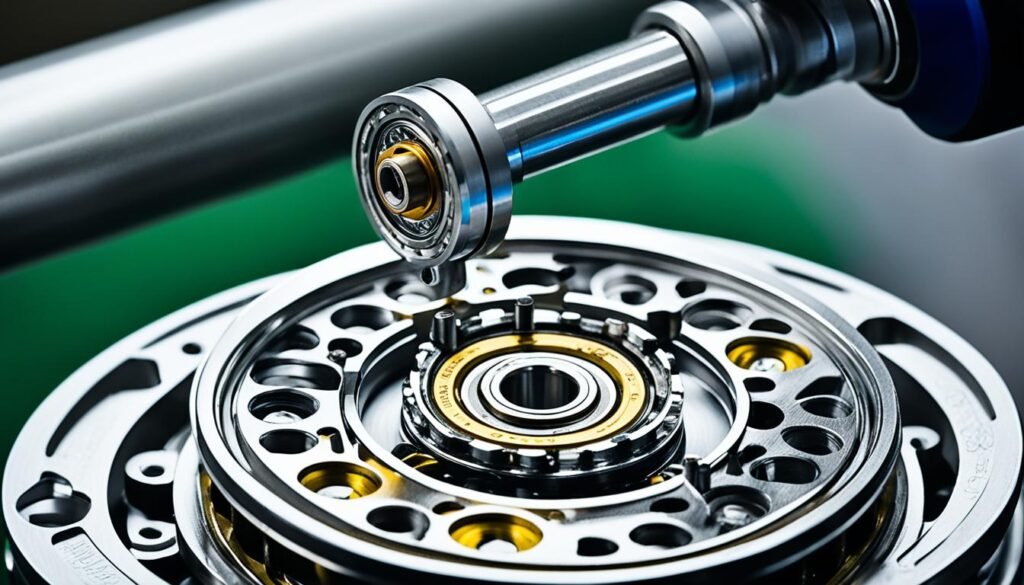
Each fly reel model may have specific recommendations for upgrades and maintenance, so it is important to refer to the manufacturer’s guidelines. Additionally, some reel manufacturers offer upgrade kits or parts specifically designed for their reels, ensuring compatibility and ease of installation.
Remember, regular maintenance and upgrades are crucial for maximizing the performance and longevity of your fly reel. By implementing these recommended tips and investing in necessary upgrades, you can enjoy smoother casts, improved line retrieval, and an overall enhanced angling experience.
Choosing the Right Bearings for Your Fly Reel
When it comes to upgrading fly reel bearings, selecting the appropriate type and size for your specific fly reel model is crucial. You want to ensure compatibility and optimal performance. Here are some important factors to consider:
- Manufacturer’s Guidelines: Refer to the reel manufacturer’s guidelines for recommended bearing types and sizes. They will provide valuable information and specifications tailored to your reel model.
- Intended Use: Consider the type of fishing you’ll be doing and the reel’s intended use. Are you targeting large fish in saltwater, or will you be using it for freshwater fishing? Different conditions may require specific bearing materials and corrosion resistance.
- Fishing Environment: Assess the fishing environment you’ll be in. Is it a wet and corrosive environment, or will freshwater be the primary setting? This knowledge will aid in choosing bearings that can withstand harsh conditions.
- Load Capacity: Evaluate the load capacity of the bearings. Heavier loads may require bearings with higher load ratings to ensure durability and longevity.
Here are two popular choices for upgrading fly reel bearings:
- Stainless Steel Bearings: These bearings are known for their durability and corrosion resistance. They provide excellent performance in a wide range of fishing environments.
- Ceramic Bearings: Ceramic bearings, made from advanced materials, offer superior strength and reduced weight. They can enhance spool speeds, resulting in longer and smoother casts.
Investing in reputable brands and seeking professional advice when unsure can help guarantee optimal performance and satisfaction with your upgraded fly reel bearings.
Example:
“Choosing the right bearings for your fly reel is paramount in achieving optimal performance. A well-informed decision based on factors such as manufacturer’s guidelines, intended use, fishing environment, and load capacity can make a significant difference. Stainless steel bearings, known for their durability, and ceramic bearings, offering enhanced speed and performance, are two popular options. Remember to invest in reputable brands and seek professional advice if needed.”
– John Smith, Reel Expert
Bearings Comparison
| Bearing Type | Durability | Corrosion Resistance | Weight | Spool Speed |
|---|---|---|---|---|
| Stainless Steel Bearings | High | Excellent | Heavier | Standard |
| Ceramic Bearings | High | Good | Lighter | Higher |
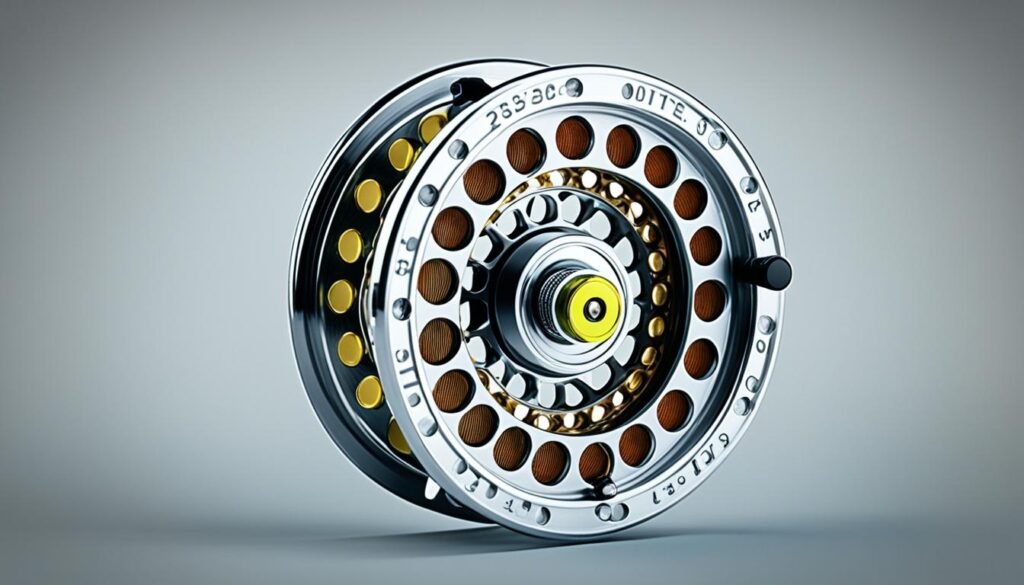
Comparing Bearing Upgrade Options
When it comes to upgrading fly reel bearings, there are several options available, each offering unique features and benefits. Choosing the right bearings is crucial for enhancing your fly fishing experience. Let’s take a closer look at the two popular options: stainless steel and ceramic bearings.
Stainless Steel Bearings
Stainless steel bearings are a top choice among anglers for their durability and corrosion resistance. These bearings are built to withstand harsh fishing conditions, making them ideal for saltwater fly fishing. They offer excellent performance and reliability, ensuring smooth casts and optimal reel functionality. With proper maintenance, stainless steel bearings can last for many seasons.
Ceramic Bearings
If you’re looking for even better performance, ceramic bearings are worth considering. These bearings are lighter and stronger than stainless steel bearings, allowing for higher spool speeds and smoother casts. The reduced weight also helps improve the overall balance of your fly reel. Ceramic bearings are known for their exceptional durability and resistance to wear. However, they can be more expensive compared to stainless steel bearings.
| Bearing Type | Features | Benefits |
|---|---|---|
| Stainless Steel Bearings | Durable, corrosion resistant | Smooth casts, reliable performance |
| Ceramic Bearings | Lightweight, strong | Higher spool speeds, smoother casts |
Aside from the bearing material, there are other factors to consider when upgrading your fly reel bearings. Pay attention to the seal design, as this can affect the bearing’s durability and protection against water and debris. Consider the ease of installation to ensure a hassle-free upgrade. Moreover, compatibility with your specific reel model is essential for seamless integration.
To make an informed decision, it’s recommended to research and compare different brands and models. Read customer reviews and seek advice from experienced anglers to find the best option that suits your needs and budget.

Upgrading your fly reel bearings can greatly enhance your fishing experience. Whether you choose stainless steel or ceramic bearings, both options offer improved performance and durability. Selecting the right bearings for your specific reel model is crucial to ensure a seamless upgrade. Take the time to compare different options and choose the one that best meets your requirements. Happy fishing!
Pros and Cons of DIY Bearing Upgrades
Upgrading fly reel bearings as a DIY project has its pros and cons. On the positive side, it allows anglers to customize their reel to their specific preferences and budget. It can also be a rewarding experience for those who enjoy hands-on projects. However, DIY upgrades require knowledge and proper tools to ensure proper installation and alignment. Mistakes or improper installation can lead to reel malfunctions or damage. In such cases, seeking professional assistance may be necessary.
Pros of DIY Bearing Upgrades
- Customization: Upgrading the bearings yourself allows you to tailor the reel to your specific needs and preferences. You have the freedom to choose the type and quality of bearings that suit your fishing style.
- Cost-Efficiency: DIY upgrades can be more cost-effective compared to purchasing a new reel with upgraded bearings. You can save money by investing in high-quality bearings and installing them yourself.
- Rewarding Experience: For anglers who enjoy tinkering with their gear, upgrading the bearings can be a satisfying and fulfilling project. It allows you to gain a deeper understanding of your reel’s inner workings.
Cons of DIY Bearing Upgrades
- Technical Knowledge: DIY upgrades require a certain level of technical knowledge and understanding of reel mechanics. Without proper knowledge and expertise, there is a risk of improper installation or alignment, which can lead to reel malfunctions.
- Tools and Equipment: Upgrading bearings may require specialized tools and equipment. Without the right tools, it can be challenging to remove old bearings and install new ones correctly.
- Potential Damage: Any mistakes or errors during the DIY upgrade process can result in reel damage or malfunction. This can be costly to repair or may even require replacing the entire reel.
Considering these pros and cons, it is important to assess your own capabilities and comfort level before attempting a DIY fly reel bearing upgrade. If you are unsure about the process or lack the necessary tools and expertise, it is always wise to seek professional assistance to ensure a successful upgrade.
Maintenance and Lubrication Tips for Upgraded Bearings
Maintenance and proper lubrication are essential for ensuring the optimal performance of upgraded fly reel bearings. By regularly cleaning the reel components and removing any dirt or debris that may affect the bearings’ functionality, you can help prolong their lifespan and maintain their smooth operation.
When cleaning the reel components, pay particular attention to areas where dirt and debris tend to accumulate, such as the spool, handle, and drag system. Use a soft brush or cloth to gently remove any particles that may have settled on the bearings or other surfaces.
After cleaning, it’s crucial to lubricate the upgraded bearings with a suitable lubricant. Apply a thin, even coat of lubricant to the bearings, ensuring they are adequately coated but not over-lubricated. This will help reduce friction and ensure smooth rotation.
It’s important to consult the manufacturer’s recommendations for lubrication frequency and the type of lubricant to use. Different reel models and bearing materials may have specific requirements. Using the recommended lubricant and following the suggested maintenance schedule will help optimize the performance of your upgraded bearings.
Regular maintenance and lubrication will not only prolong the lifespan of the upgraded bearings but also contribute to the overall longevity and performance of your fly reel.
Maintenance and Lubrication Tips for Upgraded Bearings:
- Regularly clean the reel components to remove dirt and debris.
- Focus on areas where dirt tends to accumulate, such as the spool, handle, and drag system.
- Use a soft brush or cloth to gently remove particles from the bearings and other surfaces.
- Apply a suitable lubricant to the bearings, ensuring they are adequately coated but not over-lubricated.
- Consult the manufacturer’s recommendations for lubrication frequency and the type of lubricant to use.
| Lubrication Tips | Benefits |
|---|---|
| Regular cleaning | Prevents dirt buildup and maintains optimal performance |
| Proper lubrication | Reduces friction and ensures smooth rotation |
| Following manufacturer’s recommendations | Optimizes performance and prolongs the lifespan of upgraded bearings |
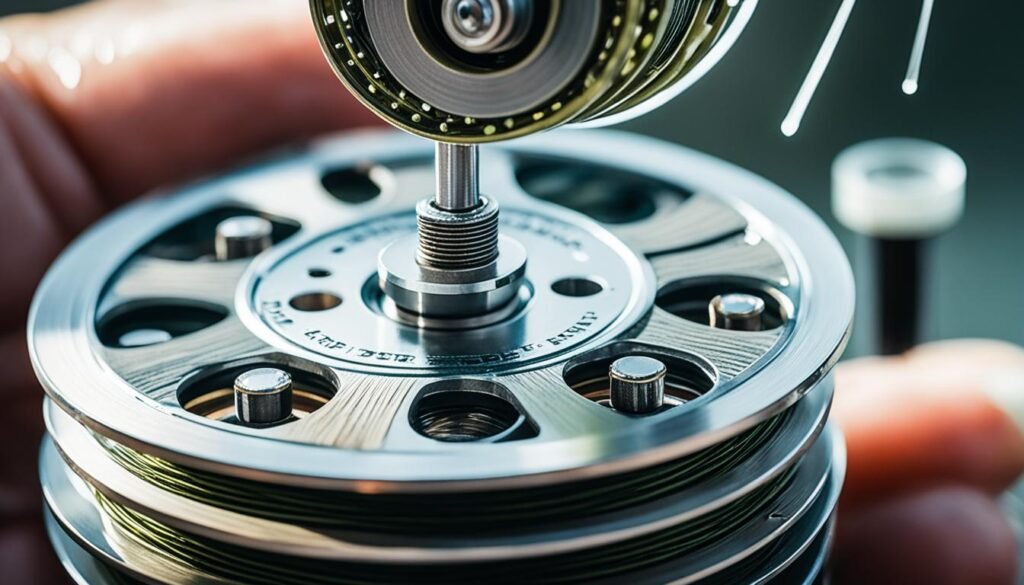
Troubleshooting Common Bearing Upgrade Issues
While upgrading fly reel bearings can greatly enhance performance, anglers may encounter common issues during the process. It’s important to be aware of these issues and know how to troubleshoot them for a successful bearing upgrade.
Incorrect Bearing Size or Compatibility
One common issue that anglers may face is using the wrong bearing size or incompatible bearings for their fly reel. This can result in an improper fit and functionality, leading to subpar performance. To avoid this issue, double-check the reel model and specifications before purchasing upgraded bearings. Ensure that the bearings you choose are compatible with your specific fly reel model.
Inadequate or Improper Lubrication
Another issue that can arise during a bearing upgrade is inadequate or improper lubrication. Lubrication is crucial for reducing friction and ensuring smooth reel operation. If the bearings are not properly lubricated, increased friction can occur, causing reduced performance and potential damage to the bearings. It’s essential to follow the manufacturer’s recommendations for lubrication and use a suitable lubricant for your upgraded bearings.
Regular inspection and maintenance are vital for identifying and resolving any issues related to the upgraded bearings. By keeping a close eye on their performance and ensuring proper fitting and lubrication, anglers can maximize the benefits of their fly reel bearing upgrades.
If problems persist or if you’re unsure about troubleshooting the issues yourself, it may be best to seek professional assistance or consult reel experts for guidance. They can provide valuable insights and expert solutions to ensure your upgraded bearings perform at their best.
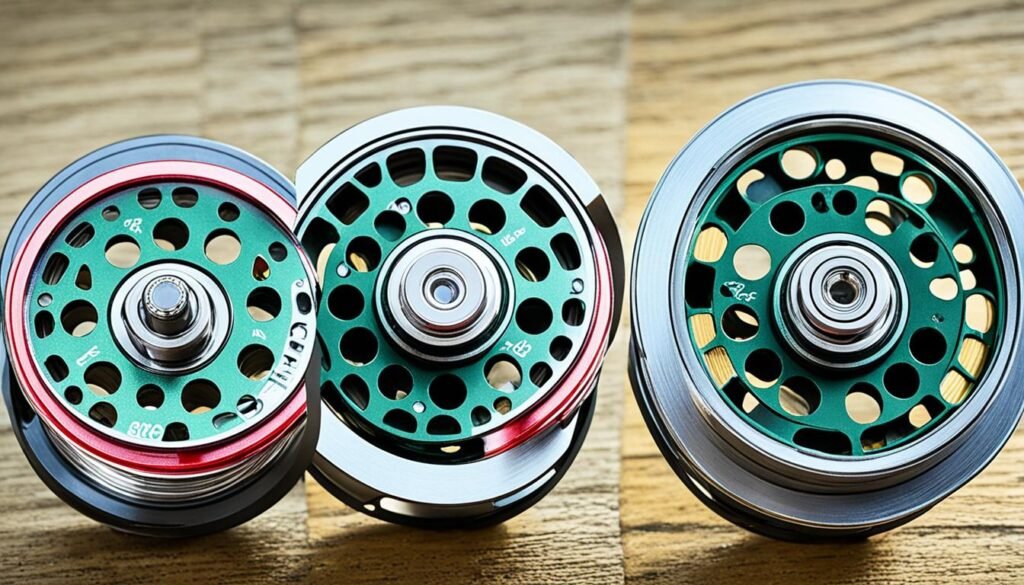
| Common Issues | Troubleshooting |
|---|---|
| Incorrect bearing size or compatibility | Double-check reel model and specifications before purchasing bearings. Ensure compatibility with the fly reel. |
| Inadequate or improper lubrication | Follow manufacturer’s recommendations for lubrication. Use a suitable lubricant for upgraded bearings. |
Conclusion
Upgrading fly reel bearings is a game-changer for anglers looking to enhance their casting performance and reel functionality. By reducing friction and minimizing vibration, upgraded bearings allow for smoother and more accurate casts, resulting in an overall improved angling experience. However, it is crucial to perform regular maintenance and proper lubrication to ensure the optimal lifespan and functionality of the upgraded bearings.
Whether you choose to undertake the DIY route or seek professional assistance, the benefits of upgrading fly reel bearings are undeniable. Properly upgraded bearings not only contribute to longer and smoother line retrieval but also enhance the overall durability and lifespan of your reel. The use of high-quality stainless steel or ceramic bearings can further elevate your reel’s performance, providing the perfect balance of strength and durability.
Investing in reputable brands and consulting reel experts can help you choose the right bearings for your specific fly reel model. By selecting the most suitable bearings based on factors such as fishing environment, load capacity, and reel specifications, you can ensure compatibility and achieve optimal results. So, go ahead and upgrade your fly reel bearings to unlock the full potential of your fishing gear and enjoy countless memorable fishing moments in the years to come.
FAQ
What is the purpose of upgrading fly reel bearings?
Upgrading fly reel bearings can improve casting performance and overall reel functionality. It reduces friction and vibration, resulting in smoother and longer casts.
How do upgraded bearings enhance reel performance?
Upgraded bearings contribute to enhanced reel performance by reducing friction and vibration, resulting in longer and smoother line retrieval.
Can upgrading fly reel bearings increase the reel’s durability?
Yes, upgrading to high-quality bearings can increase the overall durability and lifespan of the reel, saving anglers from frequent replacements or repairs.
How can I upgrade the bearings in my fly reel?
Upgrading fly reel bearings can be done as a DIY project with the right tools and knowledge. Remove the old bearings, clean the reel components, and install the upgraded bearings following the manufacturer’s instructions.
Are there any other maintenance tips and upgrades for fly reels?
Yes, regular cleaning and lubrication of the reel components, such as the drag system and gears, can prolong the lifespan and ensure smooth operation. Upgrading other parts like the handle or spool may also enhance performance.
How do I choose the right bearings for my fly reel?
Refer to the manufacturer’s guidelines or consult reel experts to determine the compatible bearings for your specific fly reel model. Consider factors like the reel’s intended use, fishing environment, and load capacity when selecting the bearings.
What are the options for upgrading fly reel bearings?
There are several options available, including stainless steel bearings known for their durability, and ceramic bearings that are lighter and stronger, allowing for higher spool speeds and smoother casts.
Is it advisable to upgrade fly reel bearings as a DIY project?
Upgrading fly reel bearings as a DIY project can be rewarding, but it requires knowledge and proper tools. Mistakes or improper installation may lead to reel malfunctions, so professional assistance may be necessary.
How should I maintain and lubricate upgraded fly reel bearings?
Regularly clean the reel components, remove any dirt or debris, and apply a suitable lubricant to the bearings. Proper maintenance and lubrication will help ensure the optimal lifespan and functionality of the upgraded bearings.
What are some common issues when upgrading fly reel bearings?
Common issues include incorrect bearing size or compatibility, leading to improper fit and functionality. Inadequate or improper lubrication can also reduce performance. Regular inspection and maintenance can help identify and resolve these issues.
What are the main benefits of upgrading fly reel bearings?
Upgrading fly reel bearings can significantly improve casting performance and overall reel functionality. It reduces friction and vibration, resulting in smoother casts, enhanced reel performance, and increased durability.

